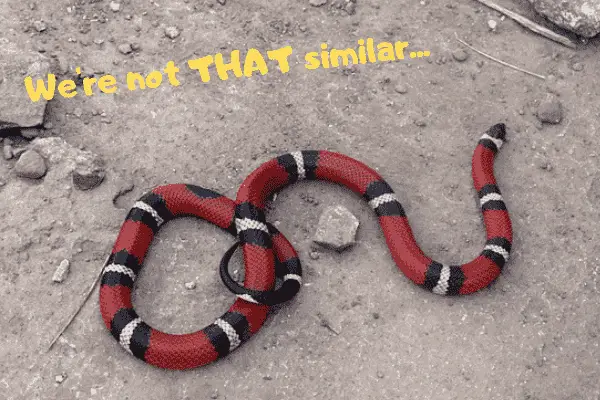When it comes to snakes, few snakes cause as much confusion as to the king snake and coral snake. The difference between these two animals is subtle on the outside, but huge when it comes to their bite! In this article: snake vs coral snake, what’s the difference and how can we tell.
Quick word: Unfortunately, it’s common for king snakes to get killed because they’re confused with coral snakes. This is one of our main reasons for writing this article.
There are certain species of king snake, like the scarlet king snake, which are rare and even becoming endangered. This makes safe disposal of snakes without harming them even more important.
There’s no reason to kill a snake at all, let alone one that’s completely harmless. Snakes will generally move away from you and don’t like to get bothered. Just scaring these red, black and yellow critters away is usually more than enough and it doesn’t have to result in the killing of innocent animals.
Knowledge is power and knowing the difference is only half the battle!
Once you know the difference between coral snakes and king snakes, you can deal with them accordingly and won’t have to harm them.

What’s the difference between a king snake and coral snake?
These two snakes are very similar. However, there are some key differences which are important for you to know. The first and most important one is that one is venomous, and the other isn’t.
Coral snake
Coral snakes are venomous and a bite can even be deadly. Coral snake bites have been linked to respiratory failure and death. If you’re feeling scientific, then this article may be for you. It gives you some more information about a coral snake’s venom and its scientific properties.
Coral snakes actually have one of the most neurotoxic venoms in North America. This goes to show the danger that these snakes can cause if not treated with caution. There’s no anti-venom currently in production and a bite from a coral snake has a 20% fatality rate.
Luckily though, these facts aren’t as bad as they first seem. For starters, coral snakes rarely bite humans and would prefer not to waste their venom on something that can’t fit in their mouth. They’re also nocturnal which means encounters with people are fairly uncommon.
Also, should you get bitten by a coral snake, they need to hold on for a little while to inject enough venom to do real damage. They tend to go into a chewing motion to inject venom which makes fatal bites even less common.
What to do if you get bitten by a coral snake?
Go to the hospital. It can take upwards of 24 hours to get any symptoms and it’s best to contact a medical professional should you get bitten by a coral snake.
King snake
King snakes are different to coral snakes and they certainly aren’t dangerous to humans. They are dangerous to snakes, however!
King snakes will often feed on other snakes, including venomous snakes.
They kill their prey by means of constriction though and aren’t large enough to do any real damage to people. They squeeze with a strength that’s twice as much as most other constrictors like pythons. It’s thought that this is because of the fact that they eat a lot of other reptiles. Reptiles don’t use as much oxygen as mammals and are therefor a little less susceptible to constriction.
There are three types of king snake that are often confused with the coral snake. These are the scarlet king snake, the Mexican king snake, and the red milk snake. Yes, milk snakes are also classed as king snakes!
So, you can probably tell why these two snakes being confused causes problems. King snakes are completely harmless, while people’s fear of coral snakes is understandable, if not a little exaggerated.

Why are they often mistaken for one another?
Answering this question is easy… Because they look so much alike! Scarlet king snakes, milk snakes and Mexican king snakes all look extremely similar to coral snakes. This mimicking behavior is common amongst animals.
There’s no better way to defend yourself than pretending to be something dangerous. This is the tactic that these king snakes use and it’s quite a clever one.
One other large and important reason is that they both live in the same areas of the USA. This causes further problems as you don’t know which of the two you have in front of you.
This is obvious when you consider the fact that king snakes look this way to mimic the coral snake as a deadly animal. There would be no point if there were no coral snakes around!
How can you tell the difference?
Now for the part that you’ve been waiting for. You’ve already learned some of the differences between the king snake vs coral snake. Now it’s time to find out how you can tell the difference when confronted with these snakes!
First, we’re going to go into some of the differences between coral snakes and king snakes. Then we’re going to show you a useful rhyme you can use to tell them apart.
Pattern
The easiest and quickest way to tell these snakes apart in North America is by observing the pattern that the snake has. If the red and yellow bands touch, then you’ve got a coral snake on your hands. If there’s a black band separating the yellow and red bands, then you’ve got a harmless king snake on your hands.
This pattern variation in the yellow, black and red bands is the easiest way to tell the difference. There’s even a useful rhyme you can use…
Rhyme for coral snakes
The rhyme for coral snakes goes like this:
Red touch yellow, kills a fellow. Red touch black, a friend of Jack.
There are ample variations of this rhyme, but it’s best not to confuse things. Just remember… Red touches yellow, kills a fellow. By just remembering this part you’ll be able to tell the difference quickly.
Head color
The head color is another tell-tale sign that you’ve got a coral snake in front of you. If the head is black, then it’s a coral snake. If the head is red and yellow (obviously separated by a black band) then you’ve got a king snake on your hands.
Just these two differences alone are pretty much all you need to find out which snake you have in front of you. However, there are a few other differences you might like to know.
Differences in behavior
When it comes to climbing trees, then coral snakes aren’t a fan. King snakes will go up into the trees from time to time, but coral snakes rarely will. This isn’t a dead giveaway, but it can be used in combination with the other differences to be even more sure of yourself!
Be careful!
These rhymes and rules are only applicable to the US. If you’re somewhere else on earth, these rhymes probably won’t work for you. There are species elsewhere that don’t abide by these rules, unfortunately.

What should I do if I come across a king snake or coral snake?
The best thing to do is nothing! Neither of these snakes are the slightest bit interested in biting you, so by just leaving them alone, you can avoid any issues. However, if they’re being really intrusive, try stomping your feet and scaring them away.
Most snakes will be long gone by the time they feel the vibrations on the floor as they don’t want to get stepped on.
If you really can’t get the snake to budge and you’re sure it’s a coral snake, then contact a snake catcher to remove the animal for you.
Conclusion
This article on the king snake vs coral snake has been quite an informative one. We’ve learned about the similarities and differences between coral snakes and king snakes. We’ve also learned what you should do if you encounter one of these snakes.
We hope that you’ve learned a lot! If there are any differences between king snakes and coral snakes we’ve missed, or you think we’ve left something else out, please shoot us a message or leave a comment. We’re always looking to improve our resources and really appreciate any feedback.
